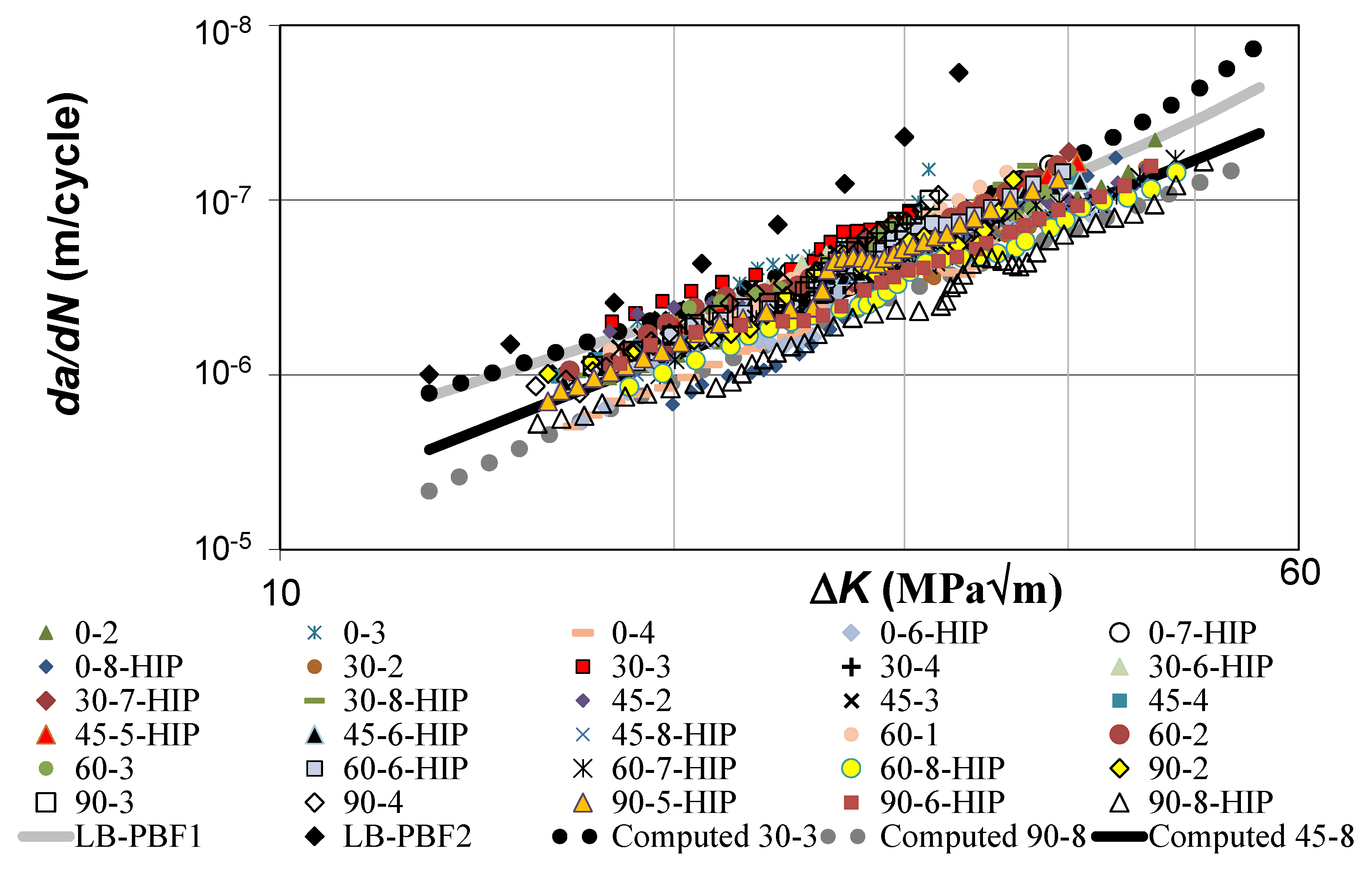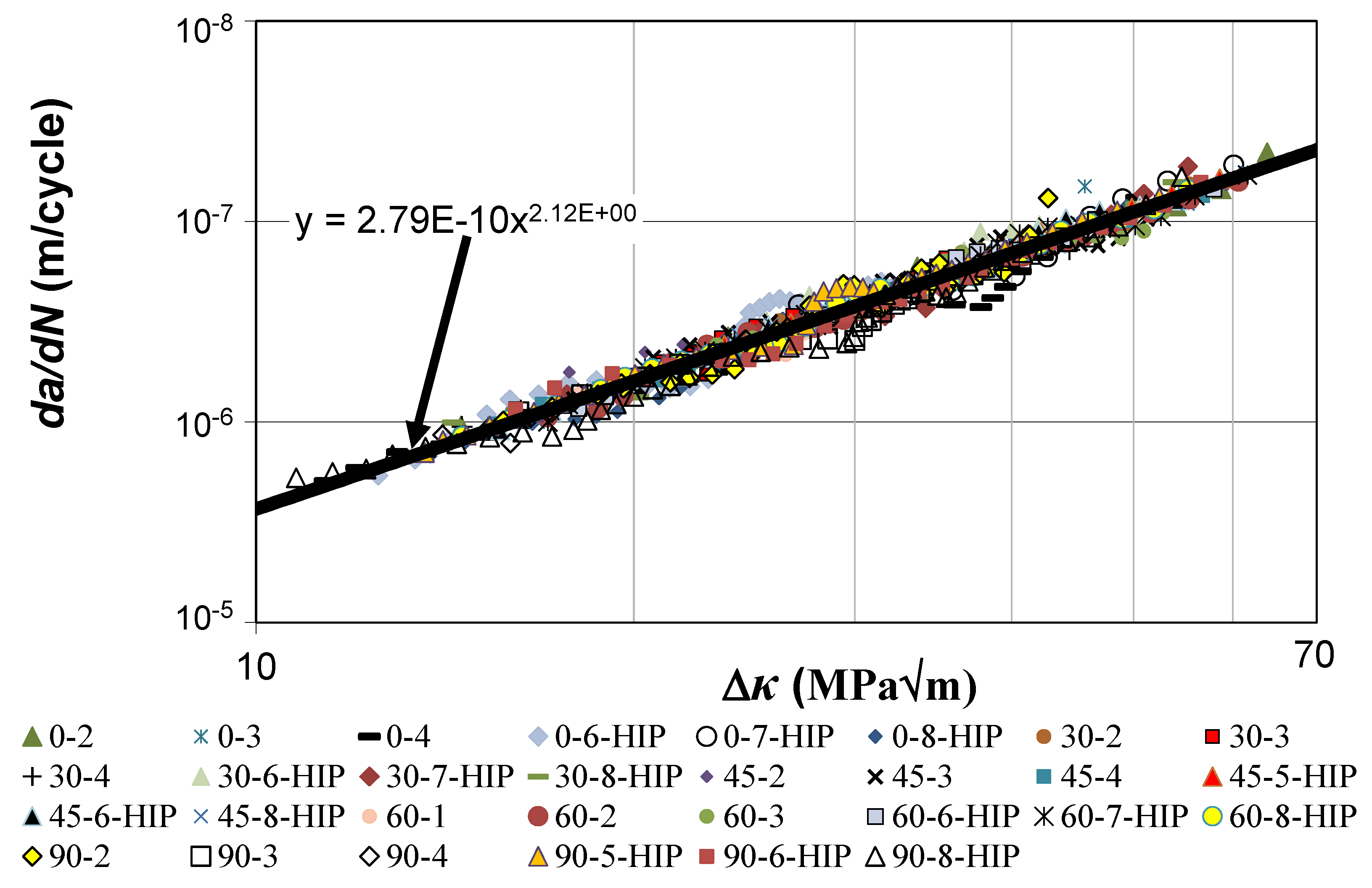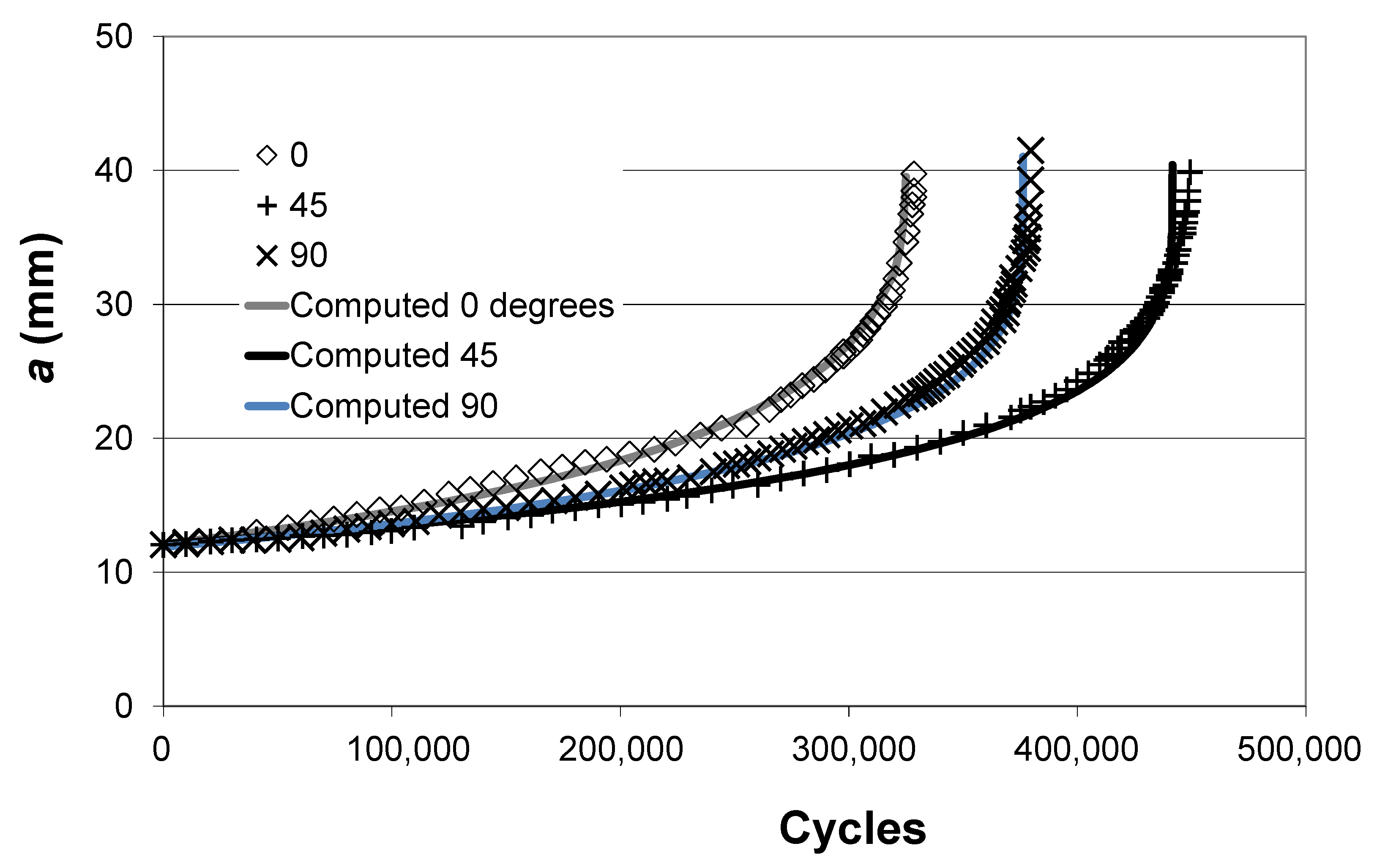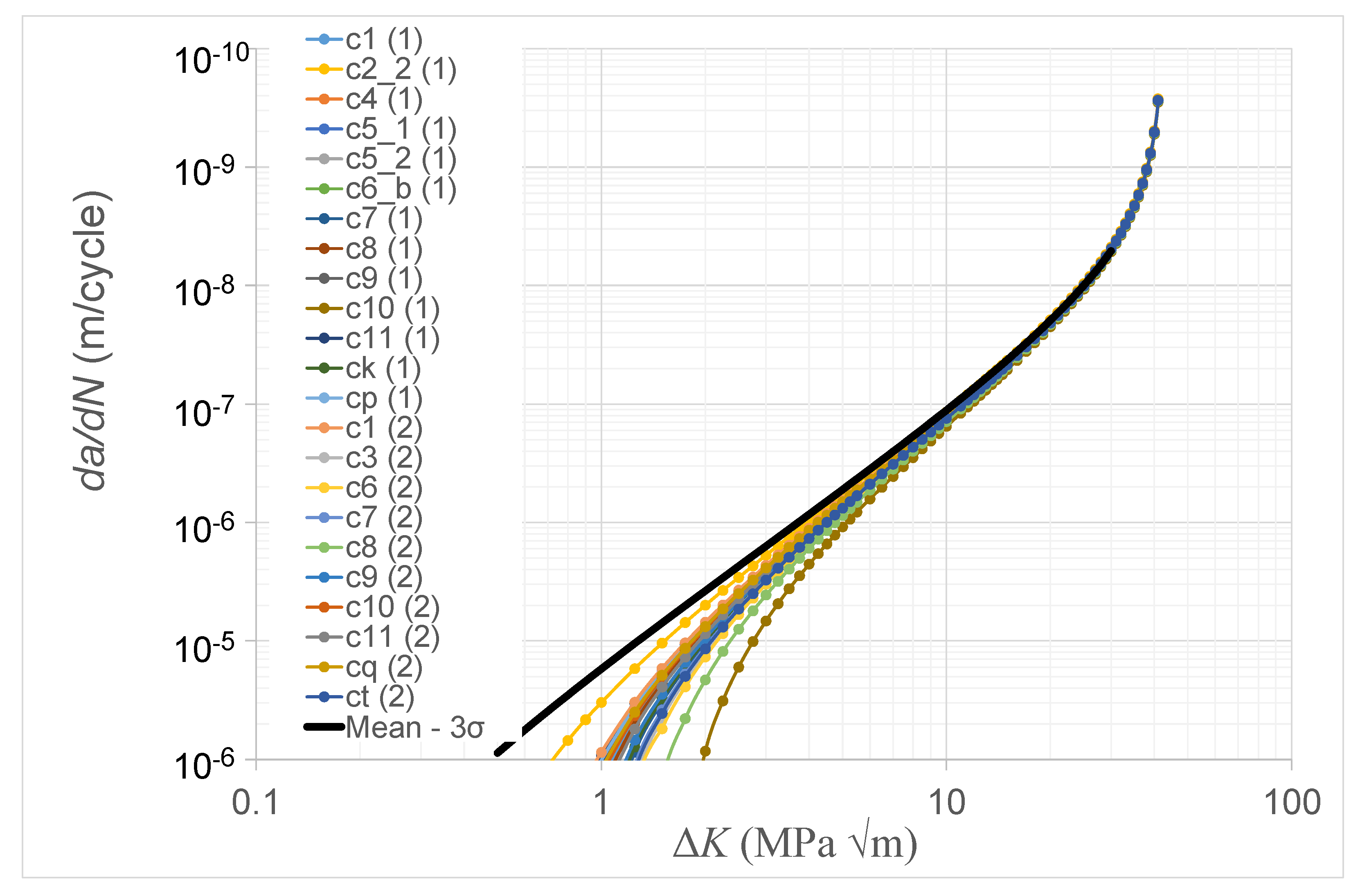Modelling the Variability and the Anisotropic Behaviour of Crack Growth in SLM Ti-6Al-4V
Abstract
1. Introduction
2. Materials and Methods
3. Modelling the Variability in SLM TI-6AL-4V
Crack Growth in ASTM Compact Tension SLM Ti-6Al-4V Specimens as Function of Crack Orientation Relative to the Build Direction
4. Implications for the Durability Analysis of AM Parts
5. Conclusions
Author Contributions
Funding
Institutional Review Board Statement
Informed Consent Statement
Data Availability Statement
Conflicts of Interest
References
- Gorelik, M. Regulatory Considerations for AM Qualification and Status of FAA Roadmap. In Proceedings of the Additive Manufacture for Reactor Materials & Components: Public Meeting, Bethesda, MD, USA, 28–29 November 2017; Available online: https://www.nrc.gov/docs/ML1733/ML17338A886.pdf (accessed on 2 February 2021).
- Gorelik, M. Lessons Learned for Structural Alloys and Implications for Metal AM F&DT Considerations. In Proceedings of the Indian Structural Integrity Society, 3rd Structural Integrity Conference and Exhibition (SICE), IIT, Mumbai, India, 11 December 2020. [Google Scholar]
- Structures Bulletin EZ-SB-19-01, Durability and Damage Tolerance Certification for Additive Manufacturing of Aircraft Structural Metallic Parts, Wright Patterson Air Force Base, OH, USA. 10 June 2019. Available online: https://daytonaero.com/usaf-structures-bulletins-library/ (accessed on 2 February 2021).
- Hrabe, N.; Barbosa, N.; Daniewicz, S.; Shamsaei, N. Findings from the NIST/ASTM Workshop on Mechanical Behavior of Additive Manufacturing Components, ASTM-NIST Workshop on Mechanical Behavior of Additive Manufactured Components, NIST Advanced Manufacturing Series 100-4. 2016. Available online: https://doi.org/10.6028/NIST.AMS.100-4 (accessed on 2 February 2021).
- MIL-STD-1530D, Department of Defense Standard Practice Aircraft Structural Integrity Program (ASIP). 13 October 2016. Available online: http://everyspec.com/MIL-STD/MIL-STD.../download.php?spec=MIL-STD-1530D (accessed on 2 February 2021).
- Department of Defense Joint Service Specification Guide, Aircraft Structures, JSSG-2006. October 1998. Available online: http://everyspec.com/USAF/USAF-General/JSSG-2006_10206/ (accessed on 10 July 2020).
- Virkler, D.A.; Hillberry, B.M.; Goel, P.K. The Statistical Nature of Fatigue Crack Propagation; Technical Report AFFDL-TR-78-43; Air Force Wright Aeronautical Laboratory: Wright Patterson Ai Force Base, OH, USA, 1978; Available online: https://apps.dtic.mil/dtic/tr/fulltext/u2/a056912.pdf (accessed on 2 February 2021).
- Iliopoulos, A.P.; Jones, R.; Michopoulos, J.G.; Phan, N.; Rans, C. Further Studies into Crack Growth in Additively Manufactured Materials. Materials 2020, 13, 2223. [Google Scholar] [CrossRef] [PubMed]
- Rans, C.; Michielssen, J.; Walker, M.; Wang, W.; Hoen-Velterop, L. Beyond the orthogonal: On the influence of build orientation on fatigue crack growth in SLM Ti-6Al-4V. Int. J. Fatigue 2018, 116, 344–354. [Google Scholar] [CrossRef]
- Molent, L.; Jones, R. The influence of cyclic stress intensity threshold on fatigue life scatter. Int. J. Fatigue 2016, 82, 748–756. [Google Scholar] [CrossRef]
- Jones, R. Fatigue crack growth and damage tolerance. Fatigue Fract. Eng. Mater. Struct. 2014, 37, 463–483. [Google Scholar] [CrossRef]
- Schwalbe, K.H. On the Beauty of Analytical Models for Fatigue Crack Propagation and Fracture-A Personal Historical Review. J. ASTM Int. 2010, 7, 3–73. [Google Scholar] [CrossRef]
- Jones, R.; Michopoulos, J.G.; Iliopoulos, A.P.; Singh Raman, R.K.; Phan, N.; Nguyen, T. Representing Crack Growth in Additively Manufactured TI-6AL-4V. Int. J. Fatigue 2018, 111, 610–622. [Google Scholar] [CrossRef]
- Jones, R.; Raman, R.S.; Iliopoulos, A.P.; Michopoulos, J.G.; Phan, N.; Peng, D. Additively manufactured Ti-6Al-4V replacement parts for military aircraft. Int. J. Fatigue 2019, 124, 227–235. [Google Scholar] [CrossRef]
- Iliopoulos, A.P.; Jones, R.; Michopoulos, J.G.; Phan, N.; Singh Raman, R.F.K. Crack growth in a range of additively manufactured aerospace structural materials, Special Issue, Civil and Military Airworthiness: Recent Developments and Challenges. Aerospace 2019, 5, 118. [Google Scholar] [CrossRef]
- Kundu, S.; Jones, R.; Peng, D.; Matthews, N.; Alankar, A.; Singh Raman, R.K.; Huang, P. Review of Requirements for the Durability and Damage Tolerance Certification of Additively Manufactured Aircraft Structural Parts and AM Repairs. Materials 2020, 13, 1341. [Google Scholar] [CrossRef] [PubMed]
- Jones, R.; Molaei, R.; Fatemi, A.; Peng, D.; Phan, N. A note on computing the growth of small cracks in AM Ti-6Al-4V. Procedia Struct. Integr. 2020, 111, 364–369. [Google Scholar] [CrossRef]
- Sanaei, N.; Fatemi, A. Defect-based fatigue life prediction of L-PBF additive manufactured metals. Eng. Fract. Mech. 2021, 244. [Google Scholar] [CrossRef]
- ASTM. Measurement of Fatigue Crack Growth Rates; ASTM: West Conshohocken, PA, USA, July 2016. [Google Scholar]
- Sun, W.; Huang, W.; Zhang, W.; Qian, X. Effects of build direction on tensile and fatigue performance of selective laser melting Ti6Al4V titanium alloy. Int. J. Fatigue 2020, 130. [Google Scholar] [CrossRef]
- Lincoln, J.; Melliere, R.A. Economic Life Determination for a Military Aircraft. AIAA J. Aircr. 1999, 36, 737–742. [Google Scholar] [CrossRef]
- Niu, M.C.Y. Composite Airframe Structures: Practical Design Information and Data; Conmilit Press: Hong Kong, China, 1992. [Google Scholar]
- Rouchon, J. Fatigue and Damage Tolerance Evaluation of Structures: The Composite Materials Response, National Aerospace Laboratory NLR, NLR-TP-2009-221, Rotterdam, The Netherlands. Available online: https://reports.nlr.nl/handle/10921/224 (accessed on 2 February 2021).
- Main, B.; Evans, R.; Walker, K.; Yu, X.; Molent, L. Lessons from a Fatigue Prediction Challenge for an Aircraft Wing Shear Tie Post. Int. J. Fatigue 2019, 123, 53–65. [Google Scholar] [CrossRef]
- Jones, R.; Molent, L.; Barter, S. Calculating crack growth from small discontinuities in 7050-T7451 under combat aircraft spectra. Int. J. Fatigue 2013, 55, 178–182. [Google Scholar] [CrossRef]
- Tan, J.L.; Chen, B.K. Prediction of fatigue life in aluminium alloy (AA7050-T7451) structures in the presence of multiple artificial short cracks. Theor. Appl. Fract. Mech. 2015, 78, 1–7. [Google Scholar] [CrossRef]




| Build Angle | Treatment | Descriptor |
|---|---|---|
| 0° | annealed at 735 °C | 00-2 |
| ibid | ibid | 00-3 |
| ibid | ibid | 00-4 |
| ibid | annealed at 735 °C and then HIPed for | 00-6 |
| ibid | 2 h at 920 °C and 1000 bar | 00-7 |
| ibid | ibid | 00-8 |
| 30° | annealed at 735 °C | 30-2 |
| ibid | ibid | 30-3 |
| ibid | ibid | 30-4 |
| ibid | annealed at 735 °C and then HIPed for 2 h at 920 °C 1000 bar | 30-6 |
| ibid | ibid | 30-7 |
| ibid | ibid | 30-8 |
| 45° | annealed at 735 °C | 45-2 |
| ibid | ibid | 45-3 |
| ibid | ibid | 45-4 |
| ibid | annealed at 735 °C and then HIPed for | 45-5 |
| ibid | 2 hrs 920 °C 1000 bar | 45-6 |
| ibid | ibid | 45-8 |
| 60° | annealed at 735 °C | 60-2 |
| ibid | ibid | 60-3 |
| ibid | annealed at 735 °C and then HIPed for | 60-6 |
| ibid | 2 hrs at 920 °C and 1000 bar | 60-7 |
| ibid | ibid | 60-8 |
| 90° | annealed at 735 °C | 90-2 |
| ibid | ibid | 90-3 |
| ibid | ibid | 90-4 |
| ibid | annealed at 735 °C and then HIPed for 2 h 920 °C 1000 bar | 90-5 |
| ibid | ibid | 90-6 |
| ibid | ibid | 90-8 |
| Build Angle | Descriptor | ∆Kthr (MPa √m) | A (MPa √m) | Coefficient of Determination (R2) |
|---|---|---|---|---|
| 0° | 00-2 | 5.10 | 88.0 | 0.97 |
| ibid | 00-3 | 1.50 | 54.5 | 0.95 |
| ibid | 00-4 | 7.80 | 73.0 | 0.91 |
| ibid | 00-6 (HIPed) | 5.40 | 107.0 | 0.96 |
| ibid | 00-7 (HIPed) | 4.92 | 67.0 | 0.95 |
| ibid | 00-8 (HIPed) | 8.20 | 70.0 | 0.99 |
| 30° | 30-2 | 5.90 | 105.0 | 0.95 |
| ibid | 30-3 | 0.10 | 63.5 | 0.97 |
| ibid | 30-4 | 4.10 | 73.0 | 0.97 |
| ibid | 30-6 (HIPed) | 1.30 | 85.0 | 0.91 |
| ibid | 30-7 (HIPed) | 2.20 | 73.0 | 0.93 |
| ibid | 30-8 (HIPed) | 2.55 | 65.0 | 0.97 |
| 45° | 45-2 | 0.10 | 134.0 | 0.98 |
| ibid | 45-3 | 1.90 | 73.0 | 0.94 |
| ibid | 45-4 | 2.70 | 85.0 | 0.99 |
| ibid | 45-5 (HIPed) | 1.50 | 76.0 | 0.99 |
| ibid | 45-6 (HIPed) | 2.40 | 90.0 | 0.98 |
| ibid | 45-8 (HIPed) | 3.10 | 128.0 | 0.99 |
| ibid | 60-1 | 3.00 | 61.0 | 0.99 |
| ibid | 60-2 | 1.90 | 74.0 | 0.99 |
| 60° | 60-3 | 0.10 | 98.3 | 0.92 |
| ibid | 60-6 (HIPed) | 3.70 | 70.0 | 0.99 |
| ibid | 60-7 (HIPed) | 3.70 | 116.0 | 0.97 |
| ibid | 60-8 (HIPed) | 5.00 | 140.0 | 0.99 |
| ibid | 90-2 | 1.95 | 93.8 | 0.85 |
| 90° | 90-3 | 5.90 | 49.7 | 0.98 |
| ibid | 90-4 | 5.01 | 51.0 | 0.99 |
| ibid | 90-5 (HIPed) | 4.00 | 80.0 | 0.98 |
| ibid | 90-6 (HIPed) | 3.80 | 123 | 0.99 |
| ibid | 90-8 (HIPed) | 6.20 | 168.0 | 0.96 |
| Mean Value | Standard Deviation | |
|---|---|---|
| Annealed at 735 °C | ||
| A (MPa × √m) | 78.6 | 23.0 |
| ΔKthr (MPa × √m) | 3.2 | 2.4 |
| Annealed at 735 °C and then HIPed for 2 hrs at 920 °C 1000 bar | ||
| A (MPa × √m) | 96.6 | 31.6 |
| ΔKthr (MPa × √m) | 3.8 | 1.9 |
| Build Direction | ∆Kthr (MPa × √m) | A (MPa √m) |
|---|---|---|
| 0° | 2.0 | 71 |
| 45° | 3.8 | 52 |
| 90° | 3.15 | 48.5 |
| Crack Descriptor | ∆Kthr (MPa √m) |
|---|---|
| c1 | 0.7 |
| c2_2 | 0.35 |
| c4 | 0.75 |
| c5_1 | 0.8 |
| c5_2 | 0.6 |
| c6_b | 0.75 |
| c7 | 0.85 |
| c8 | 0.72 |
| c9 | 0.65 |
| c10 | 1.6 |
| c11 | 0.61 |
| ck | 0.83 |
| cp | 0.63 |
| c1 | 0.6 |
| c3 | 0.95 |
| c6 | 1 |
| c7 | 0.9 |
| c8 | 1.2 |
| c9 | 0.8 |
| c10 | 0.68 |
| c11 | 0.75 |
| cq | 0.66 |
Publisher’s Note: MDPI stays neutral with regard to jurisdictional claims in published maps and institutional affiliations. |
© 2021 by the authors. Licensee MDPI, Basel, Switzerland. This article is an open access article distributed under the terms and conditions of the Creative Commons Attribution (CC BY) license (http://creativecommons.org/licenses/by/4.0/).
Share and Cite
Jones, R.; Rans, C.; Iliopoulos, A.P.; Michopoulos, J.G.; Phan, N.; Peng, D. Modelling the Variability and the Anisotropic Behaviour of Crack Growth in SLM Ti-6Al-4V. Materials 2021, 14, 1400. https://doi.org/10.3390/ma14061400
Jones R, Rans C, Iliopoulos AP, Michopoulos JG, Phan N, Peng D. Modelling the Variability and the Anisotropic Behaviour of Crack Growth in SLM Ti-6Al-4V. Materials. 2021; 14(6):1400. https://doi.org/10.3390/ma14061400
Chicago/Turabian StyleJones, Rhys, Calvin Rans, Athanasios P. Iliopoulos, John G. Michopoulos, Nam Phan, and Daren Peng. 2021. "Modelling the Variability and the Anisotropic Behaviour of Crack Growth in SLM Ti-6Al-4V" Materials 14, no. 6: 1400. https://doi.org/10.3390/ma14061400
APA StyleJones, R., Rans, C., Iliopoulos, A. P., Michopoulos, J. G., Phan, N., & Peng, D. (2021). Modelling the Variability and the Anisotropic Behaviour of Crack Growth in SLM Ti-6Al-4V. Materials, 14(6), 1400. https://doi.org/10.3390/ma14061400







